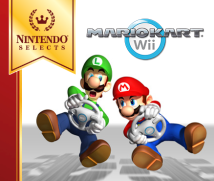3. The Many Wii Wheel Prototypes
We just took a whirlwind tour of the history of Mario Kart, and now it’s time to move on to the Wii game. You could say that the biggest change for Mario Kart Wii is the Wii Wheel. Ashida-san, could you tell us a little about how the Wii Wheel came to be?
I think it all began near the end of 2006. I suddenly got an internal call from Konno-san saying he was thinking about making a steering wheel.
Did you ever imagine that, just when you were kicking back after the launch of the Wii, you would be asked to make a steering wheel?
We’d had plans for the Wii Zapper11 from the earliest stages, and a steering wheel had been mentioned, but no one was talking about making prototypes yet. 11 Wii Zapper: A peripheral to which the Wii Remote and Nunchuk can be attached. Released in Europe in December 2007.
A steering wheel is so easy to understand. Almost everyone has the experience of using some kind of steering wheel, from riding toy cars with pedals as children, to driving real go-karts at a theme park. Everyone knows how to turn the wheel right in order to go right. Besides, I kind of wanted to make a product that would come in a big box for a change! (laughs)
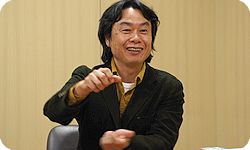
I don’t know about “for a change.” We’d just released Wii Fit! (laughs) (Wii Fit was released in Japan on December 2007. European release is scheduled for April 25 2008)
(laughs)
So there was talk of making a steering wheel. How did you get started?
(laugh)
Early in 2007, just after the release of Wii, I got my hands on a pre-production version of Mario Kart Wii. Konno-san had already prepared a steering wheel all on his own. It housed the Wii Remote, and was ready for gameplay. I experienced game maneuvering in a way I never had before and instinctively thought, “This could work!” A lot of steering wheel-like peripherals have been on the market for some time now.

And some of them are so realistic they could be used at amusement parks.
But the Wii Wheel is different in that it doesn’t have a drive shaft. It’s a wheel that’s used mid-air. It’s incredibly light, and when I checked it out, it felt really fun. With a complex product, it’s difficult to get an image of the final design. But with this it took no time at all to picture the design. We made various prototypes, and I’ve brought them today.
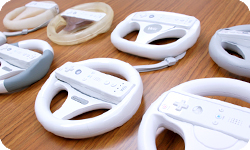
Some people might think it looks small when they first see it, but looking at all these, I now know that it’s been small ever since the first prototype.
A real go-kart’s wheel is about the same size. We thought this size would be ideal for use by entire families, from children to grandparents. Here, this is the very first prototype that was made...
I notice the Wii Remote sticks out a little.

We made this because we were trying to figure out where, when you’re holding the wheel, it would be best to house the Wii Remote. It’s kind of a weird design, isn’t it? (laughs) But by making these models, we learned which fingers would be best for gripping it. Also, we hadn’t decided yet on whether the B Button would be used, so there’s nothing on the back. We checked out some real go-kart wheels, and saw that they’re usually square steering wheels today rather than round ones. So we made this.
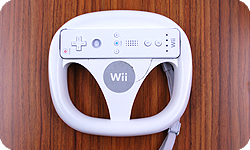
It’s a cleaner design, and the Wii Remote doesn’t jut out.
Right. There’s a hole in the back so you can press the B Button, and since there are times when you have to operate the Wii Menu, we put a window in for the pointer.

So this became the basis for the final product?
Yes, I felt a firm conviction that a normal round wheel would be easier to understand for people who would play Mario Kart Wii, so we made this one, further revising the usability along with the design.

While we were making prototypes like these, we went through a process of trial and error. In particular, only opening a hole for the B Button, made it difficult for a child’s small hand to reach, so we put a B Button on the wheel itself, where even a child’s finger can reach. We designed it so that the button pushes on the B Button of the Wii Remote. Konno-san’s team used that to play the game, and built up test results.
If we felt anything strange when holding the wheel, we told Ashida-san immediately.
You say that you repeated over and over the process of making and testing prototypes. About how many models did you make before you reached the wheel’s final form?
Probably about 30. With regard to weight, we thought carefully about how many grams would best suit gameplay. When considering durability, we wanted to make something strong using thick materials, but increasing the weight by even 30 grams would have been considered too heavy for some people. We eventually designed it to be as light as possible so people could use it for a long time without getting tired too quickly.
Why did you decide to make it white?
Actual cars don’t usually have white steering wheels, so we were considering a design that would look like a steering wheel but have a two-tone color scheme, as in this one.
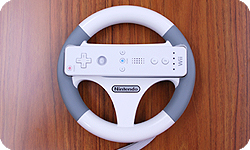
We had been considering various possibilities for the design of the Wii peripherals ever since the development of the Wii itself. Starting with the Classic Controller, however, we kept releasing products such as the Wii Zapper and Wii Balance Board that were pure white, so it only seemed natural to make the Wii Wheel pure white as well.
But there’s a blue ring on the back. That cost some money. (laughs)
If you look at the prototypes, you can see they all have the Wii logo on the front. Why is the logo on the back in the final design?
If it were on the front, the player would always see it, but since this would be held mid-air, you could say that even on the back, it’s on the front to someone who’s watching someone else play. Since it would be sort of sad if there were nothing but a screw there, we thought it would be more fun for people watching someone play if there was a blue ring on it.
As a result, we used the blue ring in the logo for Mario Kart Wii.
It costs a lot, so we needed it to do a lot of work! (laughs)
